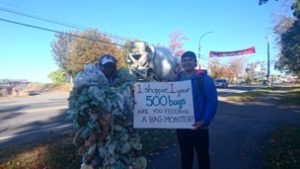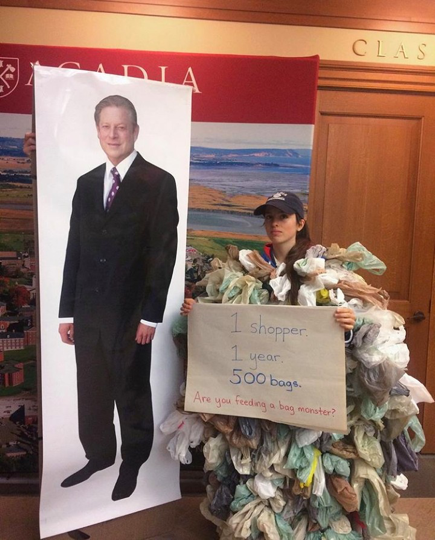Are You Feeding a Bag Monster?
Ok, you’re probably wondering what on earth I’m talking about when I say, “feeding a bag monster”, right? Well before you exclaim, “I can barely feed myself on my student budget and schedule, let alone feed someone else!” let me explain.
You know those disposable plastic shopping bags you get from the grocery store and other stores? Although they may seem convenient, if you get plastic bags every time you go to the store, they begin to add up, and add up, and can grow into menacing, problematic creatures – Bag Monsters!
Recently, a Bag Monster was wandering around Wolfville and the Acadia campus. That Bag Monster was composed of 500 bags, which represents the approximate annual consumption of single-use disposable bags by North Americans![i] 1 shopper, 1 year, 500 bags – now that’s pretty scary! However, perhaps even more concerning, is that many of us will never notice that we are feeding Bag Monsters unless we keep all of our single-use plastic bags for an entire year. Instead, we only see small Bag Monsters stuffed under the kitchen sink, in our garbage, floating on the sides of the street… But regardless of whether we know it or not, every time we use plastic bags, we are feeding Bag Monsters in our community and contributing to a global Bag Monster invasion!
Bag Monsters are wreaking havoc in Wolfville, in North America, and around the world. In the Annapolis Valley, Valley Waste Resource Management receives about 2,700 tonnes of plastic film each year, which includes shopping bags and other plastic packaging. The vast majority of these plastic bags are unnecessary and could have been avoided by using reusable bags. Instead, 1,000,000 kg of clean plastic film and another 1,000,000 kg of soiled plastic film end up in the landfill annually in the Valley, while only about 680,000 kg of plastic film are recycled, and this has significant costs, both environmental and economic.[ii]
Worldwide, a trillion single-use plastic bags are used each year, with nearly 2 million used each minute, unleashing a continuous stream of bag monsters into our environment.[iii] To illustrate the scale of this problem: if all Americans (and only Americans) tied their annual consumption of plastic bags together in a giant chain, this chain would wrap around the equator about 1,330 times! [iv] Bag Monsters are quite literally strangling our Earth, especially since the majority of plastic bags aren’t recycled, so Bag Monsters end up forming in our landfills, on the sides of roads, in rivers and oceans, and along shorelines. These Bag Monsters are practically eternal, taking at least 1,000 years to break down, and even then they don’t biodegrade but instead only fragment into small pieces over time. Marine and land animals often ingest these plastic particles, and birds and turtles are frequently found with stomachs full of plastic, including recent studies that have found plastics in the majority of marine bird stomachs.[v] This is an increasing problem as the trillions of tons of plastic particles in the oceans increase each year and never biodegrade.[vi] More so, large Bag Monsters that have not been fragmented can entangle marine species, suffocating and cutting them, and plastic bags have been identified as the most harmful items to marine animals of the vast multitudes of large plastics in our oceans.[vii]

Additionally, the production of plastic bags requires petroleum to create the plastic and act as an energy source during the manufacturing process. Therefore, the continued demand for disposable plastic bags encourages the extraction of fossil fuels, contributing to greenhouse gas emissions and using up valuable finite resources only to dispose of the bags soon afterwards. The Bag Monsters we create are sucking energy from our societies. In fact, the amount of energy required to make just 12 plastic bags could drive a car for a mile (or 1.6 km)! How far could you drive with the plastic bags you have used this year?
Bag Monsters are the frightening result of our dependency on, and excessive consumption of, plastic. In fact, Bag Monsters are not just made of single-use shopping bags, but can form from all types of excessive plastic bags and packaging. These Bag Monsters just keep growing the more we use plastic bags… soon they will take over, with detrimental consequences for the planet. How many Bag Monsters are there in your house, in your community?
It is evident that Bag Monsters are a huge problem, so what can we do about it? Well, a healthy and sustainable future free of these monsters is possible, we just all have to take a few easy steps to fight back against the Bag Monster invasion of our communities and the Earth.
Simple tips to combat Bag Monsters:
- Use reusable shopping bags! They don’t cost much and will last a long time. Keep them in a handy place near the door so you don’t forget when leaving the house.
- If you forget a reusable bag…
- Just say “no” to a plastic bag and hand-carry your things out of the store
- If necessary, try to use as few plastic bags as possible to carry your stuff
- Recycle your plastic shopping bags. Place all bags into one bag and tie closed, then put into your blue bag (#2 for containers).
- Reuse existing plastic bags.
- Buy fewer products that come in plastic bags or packaging.
- Buy in bulk when possible, and bring your own containers (e.g. new or reused mason jars) to avoid using plastic bags.
- Educate others about the Bag Monster problem, and encourage them to take action!
[i] Suzuki, D. (2012, January 10). Stop Being a Bag Lady (or Bag Guy). Retrieved from http://www.huffingtonpost.ca/david-suzuki/plasticbagban_b_1725998.html?utm_hp_ref=ca-plastic-bag-ban; Keller, A. (2011, September 28). What is a Bag Monster? Retrieved from http://www.bagmonster.com/2011/09/what-is-a-bag-monster.html
[ii] Valley Waste Resource Management.
Estimated costs to recycle and landfill plastic film is ~$250,000 for the Annapolis Valley per year).
[iii] Earth Policy Institute. (2014, October). Plastic Bags Fact Sheet. Retrieved from http://www.earth-policy.org/images/uploads/press_room/Plastic_Bags.pdf
[iv] Earth Policy Institute, 2014.
[v] Xanthos, D., & Walker, T. R. (2017, May 15). International policies to reduce plastic marine pollution from single-use plastics (plastic bags and microbeads): A review. Marine Pollution Bulletin, 118 (1–2), 17-26. Retrieved from https://doi.org/10.1016/j.marpolbul.2017.02.048; Suzuki, 2012.
[vi] Xanthos & Walker, 2017.
[vii] Xanthos & Walker, 2017.






That’s great, Caroline! One more thing: the Canadian Plastics Industry Association, and in the U.S., the ACC, have for decades lobbied governments to prevent any restrictions on their activities, and from their point of view our waste is their profit. Which is why their preferred term for the vast ecological disaster of plastics in the ocean is ‘litter’: they blame us, not themselves for the problem, even though the constant replacement of one-use plastic items is the corner-stone of the plastics industry business plan.
While I fully support economic activity which does not inflict irreparable harm to the biosphere, the plastics industry today does not fit this condition, and is sorely in need of much more oversight and control.
Excellent article – keep up the good work!